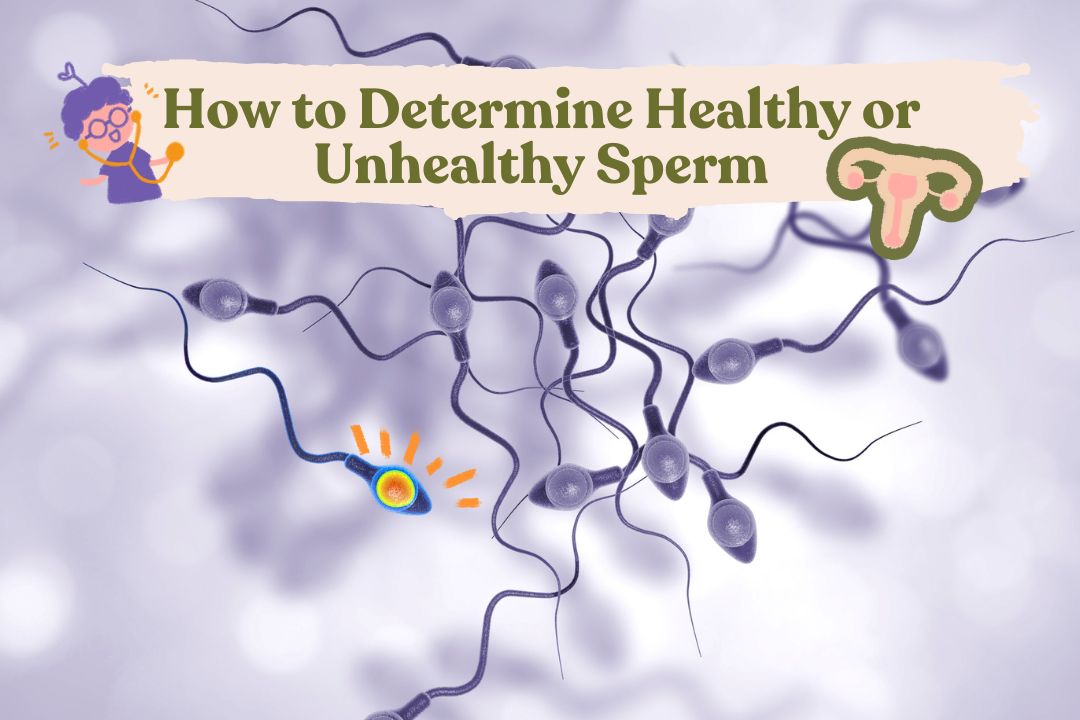How to Determine Healthy or Unhealthy Sperm

Is your sperm healthy? Here are ways to find out. Infertility is not just a problem for women. About 33 percent of it is contributed by male factors as the cause of infertility. Certainly, healthy sperm is the key to male fertility. However, healthy sperm is not only about fertility, in the sense of being able to produce a pregnancy. Quality sperm actually plays a crucial role in the continuation of pregnancy itself and also the health of the fetus.
So, how can you determine if the sperm you have is healthy? Essentially, physical characteristics of sperm such as color, smell, consistency, and volume can vary from one individual to another, and even from one ejaculation to the next. Although these physical characteristics cannot indicate whether the sperm is truly of good quality, there are certain characteristics that characterize healthy sperm.
What is semen or sperm fluid?
Firstly, it needs to be clarified that the term “sperm” here refers to sperm fluid or semen in medical terms. Semen is a milky white body fluid that is released from the penis during ejaculation. This fluid contains sperm cells (spermatozoa) and a viscous syrup-like fluid, known as seminal fluid. The seminal fluid functions to transport sperm, provide nutrients, and create a stable environment for sperm to survive for up to five days to allow fertilization.
Sperm cells are produced in the testes. From there, sperm cells enter a coiled tube called the epididymis. In this organ, sperm cells are stored and mature under the influence of hormones produced by the testes and the pituitary gland of the brain. After that, sperm cells move through a long muscular tube called the vas deferens. Here, sperm cells mix with the seminal fluid released by the ejaculatory ducts. The end result is semen.
The seminal fluid itself is a mixture of fluids produced by three glands, namely:
Tanya Mincah tentang Promil?
- Cowper’s gland: This walnut-sized organ produces fluid that serves as lubrication and neutralizes acid to keep sperm cells alive.
- Prostate gland: This walnut-sized organ releases fluid that keeps the semen in a liquid state while providing nutrients and enzymes that promote the health and protection of sperm cells.
- Seminal vesicles: These are a pair of tube-shaped glands that release fluid rich in fructose and prostaglandin. Fructose – which is a type of simple sugar – is used by sperm cells as an energy source, while prostaglandins play a role in the movement of sperm cells in the female reproductive tract.
During ejaculation, strong contractions of the muscles in the penis shaft push the semen out through the urethra.
Physical Characteristics of Healthy Sperm
Healthy sperm can be partially observed from their physical characteristics, such as:
1. Sperm Volume:
The volume of sperm released during ejaculation can vary. A study published in the Journal of Andrology in 2012 mentioned that the average volume of ejaculated fluid is 3.4 mL or about 2/3 of a teaspoon. If the volume is less than 1.5 mL, the chances of conception are considered lower. However, a small volume of sperm does not always indicate infertility or specific diseases. It could be a sign of dehydration or too frequent ejaculation.
2. Smell and Taste:
Sperm fluid is alkaline, with a normal pH ranging from 7.2 to 8.0. Therefore, it smells more like ammonia or chlorine. In terms of taste, sperm fluid tends to be slightly sweet due to its high fructose content.
Certain foods can alter the smell and taste of sperm, making it bitter, spicy, or fragrant. For example, alcohol, asparagus, cabbage, coffee, dairy products, garlic, red meat, and onions may affect the smell and taste. On the other hand, foods like celery, parsley, and pineapples can make the smell and taste sweeter. The consumption of multivitamins may give the sperm a metallic or mineral-like taste.
Smoking can also alter the smell and taste of sperm, besides reducing overall sperm quality. Other factors that may affect the smell and taste of sperm are urinary tract infections or sexually transmitted infections such as chlamydia, gonorrhea, and trichomoniasis.
3. Color and Consistency:
Normal sperm is usually pale whitish or slightly yellowish in color. Its consistency is somewhat similar to egg whites or a bit like jelly. Sometimes jelly-like clumps may be found in sperm, which is normal if a man is dehydrated or has not ejaculated for a long time.
Changes in the color or consistency of sperm do not always mean something is wrong. However, certain changes may indicate underlying health issues.
- Clear and watery sperm may be considered normal if ejaculation is frequent and frequent water intake is maintained, or if the testes are in a warm condition due to wearing tight underwear or engaging in heavy exercise. However, it may also indicate a deficiency of the mineral zinc or oligozoospermia, which is a low sperm count (<15 million sperm cells per mL).
- Sperm that appears red or brown indicates the presence of blood. Although it may seem alarming, this condition (called hemospermia) is usually not serious. In most cases, it is a normal occurrence due to the rupture of small blood vessels in the seminal vesicles or prostate gland during erections or ejaculations. Other causes include prostate enlargement, epididymitis, orchitis (testicular inflammation), sexually transmitted infections, testicular injury, kidney or bladder stones, post-prostate biopsy, and post-vasectomy.
- Yellowish or greenish sperm is almost always abnormal. Causes include sexually transmitted infections, prostatitis (prostate inflammation due to infection), jaundice, and piospermia (presence of white blood cells in sperm fluid that can damage and weaken sperm cells).
How to Assess Sperm Health
To ensure whether sperm is truly healthy and of good quality, men need to undergo a sperm analysis in a laboratory. The indicators measured are as follows:
1. Sperm Count:
The normal sperm count is about 15 million or more per milliliter (mL) of sperm fluid. The higher the sperm count, the higher the chances of conception.
2. Motility or Movement:
For sperm to reach the egg, they must have progressive movement, meaning they move fast in a straight line at a minimum speed of 25 micrometers per second. To be considered normal, at least 40 percent or more of the sperm in a sample should have effective motility.
3. Morphology or Shape:
Healthy sperm have oval heads and long, strong tails. Abnormal sperm may have round heads, peculiar shapes, more than one head, or more than one tail. According to Kruger’s criteria, at least 4 percent of sperm with normal shape are needed for successful fertilization.
Factors Affecting Sperm Health
Several factors can influence your sperm health. Some can be changed or modified, while others cannot.
- Hot Environmental Conditions: Testicles function optimally in slightly cooler conditions than the body’s core temperature. That’s why they are located outside the body cavity. Therefore, wearing tight or synthetic underwear and frequent hot baths or saunas can reduce sperm production and quality.
- Alcohol: Alcohol consumption can increase estrogen production in the liver, which can lower sperm count. Moreover, alcohol compounds can directly damage sperm-producing cells in the testicles.
- Medications: Some medications can affect male fertility, such as steroids (corticosteroids, anabolic steroids, and testosterone replacement therapy), chemotherapy drugs, marijuana, and opiates.
- Harmful Environmental Chemicals: Some compounds are suspected of having negative effects on sperm, such as phthalates in perfumes, certain pesticides, organic mercury, and estrogen in water supplies.
- Smoking: Studies have shown that smokers have lower fertility rates than non-smokers. This is because compounds in cigarettes affect sperm movement and overall quality.
- Timing: The normal sperm count is higher in the morning.
- Too Frequent or Infrequent Ejaculation: Both can affect sperm count and quality. To optimize sperm count and quality, men are advised to have intercourse or ejaculate every 2-3 days.
- Diet: A healthy and balanced diet rich in fruits, fiber, and vegetables is crucial. Antioxidant-rich foods, such as L-carnitine and lycopene, can help optimize sperm health.
- Supplements: Studies have shown that supplements containing antioxidants (L-carnitine), folic acid, selenium, and the mineral zinc can help improve sperm count and function.
In conclusion, some changes in the smell, taste, color, volume, or consistency of sperm can be normal or abnormal. Any changes should still be investigated, especially if they persist or worsen. If you are concerned about unhealthy sperm or infertility, consult a doctor promptly. The doctor will conduct an interview and physical examination to assess your overall health condition. Simple tests on sperm and blood samples can be performed to clarify the cause.
- Alwaal A, Breyer BN, Lue TF. Normal male sexual function: emphasis on orgasm and ejaculation. Fertil Steril. 2015 Nov;104(5):1051–60. doi:10.1016/j.fertnstert.2015.08.033 American Society of Reproductive Medicine. Sperm Morphology (Shape): Does It Affect Fertility?. URL: https://www.reproductivefacts.org/news-and-publications/patient-fact-sheets-and-booklets/documents/fact-sheets-and-info-booklets/sperm-morphology-shape-does-it-affect-fertility/
- Franken DR, Oehninger S. Semen analysis and sperm function testing. Asian J Androl. 2012;14(1):6-13. doi:10.1038/aja.2011.58
- Hussein, A. (2018). Overview Treatment and Male Reproductive Medicine. Encyclopedia of Reproduction, 307–313. doi:10.1016/b978-0-12-801238-3.64782-7
- Centola, G. M. (2018). Understanding Bulk Seminal Parameters. Encyclopedia of Reproduction, 50–53. doi:10.1016/b978-0-12-801238-3.64834-1





